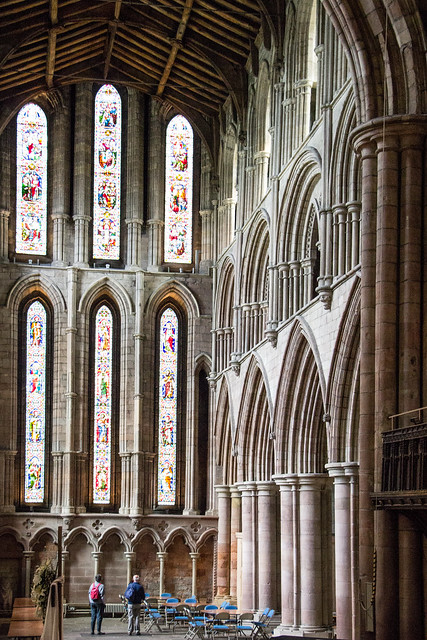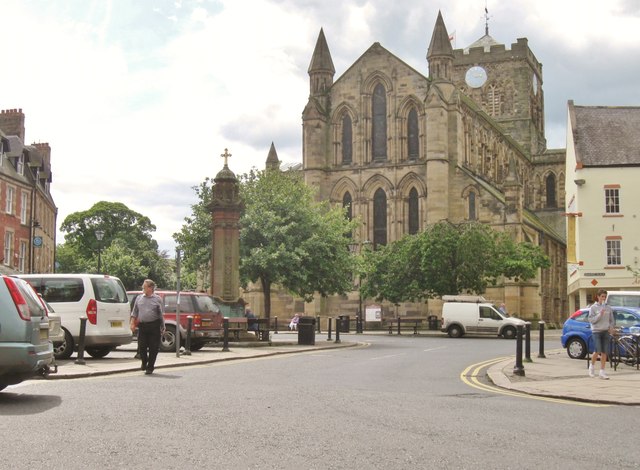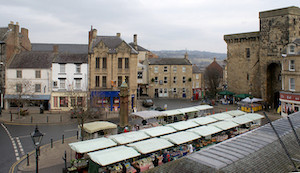Hexham Abbey, Hexham, England

-
Description
"Hexham Abbey is a Grade I listed place of Christian worship dedicated to St Andrew, in the town of Hexham, Northumberland, in northeast England. Originally built in AD 674, the Abbey was built up during the 12th century into its current form, with additions around the turn of the 20th century. Since the Dissolution of the Monasteries in 1537, the Abbey has been the parish church of Hexham. In 2014 the Abbey regained ownership of its former monastic buildings, which had been used as Hexham magistrates' court, and subsequently developed them into a permanent exhibition and visitor centre, telling the story of the Abbey's history. here has been a church on the site for over 1300 years since Etheldreda, Queen of Northumbria made a grant of lands to St Wilfrid, Bishop of York c.674. Of Wilfrid's Benedictine abbey, which was constructed almost entirely of material salvaged from nearby Roman ruins, the Saxon crypt still remains; as does a frith stool, a 7th/8th century cathedra or throne. For a little while around that time it was the seat of a bishopric. In the year 875, Halfdene (Halfdan Ragnarsson) the Dane ravaged the whole of Tyneside and Hexham Church was plundered and burnt to the ground. About 1050, one Eilaf was put in charge of Hexham, although as treasurer of Durham, he probably never went there. Eilaf was instructed to rebuild Hexham Church, which then lay in utter ruin. His son Eilaf II completed the work, probably building in the Norman style. In Norman times, Wilfrid's abbey was replaced by an Augustinian priory. The current church largely dates from c.1170–1250, built in the Early English style of architecture. The choir, north and south transepts and the cloisters, where canons studied and meditated, date from this period. The east end was rebuilt in 1858. The Abbey was largely rebuilt during the incumbency of Canon Edwin Sidney Savage, who came to Hexham in 1898 and remained until 1919. This mammoth project involved re-building the nave, whose walls incorporate some of the earlier church, and the restoration of the choir. The nave was re-consecrated on 8 August 1908. The church was recorded as Grade I listed in 1951. In 1996 an additional chapel was created at the east end of the north choir aisle; named St Wilfrid's Chapel, which offers a place for prayer or quiet reflection. Hexham (/ˈhɛksəm/ HEKS-əm) is a market town and civil parish in Northumberland, England, south of the River Tyne, and was the administrative centre for the Tynedale district from 1974 to 2009. In 2011, it had a population of 11,829. Smaller towns and villages around Hexham include Corbridge, Riding Mill, Stocksfield and Wylam to the east, Acomb and Bellingham to the north, Allendale to the south and Haydon Bridge, Bardon Mill and Haltwhistle to the west. Newcastle upon Tyne is about 25 miles (40 km) to the east and Carlisle is 37 miles (60 km) to the west. Hexham Abbey originated as a monastery founded by Wilfrid in 674. The crypt of the original monastery survives, and incorporates many stones taken from nearby Roman ruins, probably Corbridge or Hadrian's Wall. The current Hexham Abbey dates largely from the 11th century onward, but was significantly rebuilt in the 19th century. Other notable buildings in the town include the Moot Hall, the covered market, and the Old Gaol. The Anglo-Saxon Chronicle (Manuscript D: Cotton Tiberius B IV) records the murder of King Ælfwald by Sicga at Scythlecester (which may be modern Chesters) on 23 September 788: This year Alfwald, king of the Northumbrians, was slain by Siga, on the ninth day before the calends of October; and a heavenly light was often seen on the spot where he was slain. He was buried at Hexham in the church. The name of Hexham derives from the Old English Hagustaldes ea and later Hagustaldes ham whence the modern form (with the "-ham" element) derives. Hagustald is related to the Old High German hagustalt, denoting a younger son who takes land outside the settlement; the element ea means "stream" or "river" and ham is the Old English form of the Modern English "home" (and the Scots and Northern English "hame"). Like many towns in the Anglo-Scottish border area and adjacent regions, Hexham suffered from the border wars between the kingdoms of Scotland and England, including attacks from William Wallace who burnt the town in 1297. In 1312, Robert the Bruce, King of Scotland, demanded and received £2000 from the town and monastery in order for them to be spared a similar fate. In 1346 the monastery was sacked in a later invasion led by King David II of Scotland. In 1464 during the Wars of the Roses, the Battle of Hexham was fought somewhere to the south of the town; the actual site is disputed. The defeated Lancastrian commander, Henry Beaufort, 3rd Duke of Somerset, was executed in Hexham marketplace. There is a legend that Queen Margaret of Anjou took refuge after the battle in what is known as The Queen's Cave, where she was accosted by a robber; the legend formed the basis for an 18th-century play by George Colman the Younger (The Battle of Hexham: A Comedy in Three Acts); but it has been established that Queen Margaret had fled to France by the time the battle took place. The Queen's Cave in question is on the south side of the West Dipton Burn, to the southwest of Hexham. Until 1572, Hexham was the administrative centre of the former Liberty or Peculiar of Hexhamshire. In 1715, James Radclyffe, 3rd Earl of Derwentwater, raised the standard for James Francis Edward Stuart in Hexham Market place. The rising, however, was unsuccessful, and Derwentwater was captured and beheaded after the Battle of Preston. In 1761, the Hexham Riot took place in the Market Place when a crowd protesting about changes in the criteria for serving in the militia was fired upon by troops from the North Yorkshire Militia. Fifty-one protesters were killed, earning the Militia the sobriquet of The Hexham Butchers. Throughout the eighteenth and nineteenth centuries, Hexham was a centre of the leather trade, particularly renowned for making gloves known as Hexham Tans—now the name of a vegetarian restaurant in the town. "Hexham" was used in the Borders as a euphemism for "Hell". Hence the term "To Hexham wi’ you an’ ye’r whussel!", recorded in 1873, and the popular expression "Gang to Hexham!". "Hexham-birnie" is derived from the term and means "an indefinitely remote place"." - info from Wikipedia. Summer 2019 I did a solo cycling tour across Europe through 12 countries over the course of 3 months. I began my adventure in Edinburgh, Scotland and finished in Florence, Italy cycling 8,816 km. During my trip I took 47,000 photos. Now on https://www.instagram.com/billyd.wilson/" rel="noreferrer nofollow">Instagram. Become a patron to my photography on https://www.patreon.com/billywilson" rel="noreferrer nofollow">Patreon. -
Owner
Billy Wilson Photography -
Source
Flickr (Flickr) -
License
What does this mean? Attribution-NonCommercial License
-
Further information
Link: https://www.flickr.com/photos/32132568@N06/49972101951/
Resource type: Image
Added by: Pat Thomson
Last modified: 4 years, 10 months ago
Viewed: 407 times
Picture Taken: 2019-05-19T11:43:36 -
Co-Curate tags







